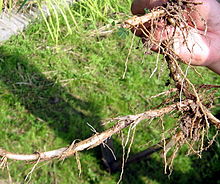Perennial rice
Agronomists have argued that increasing the amount of agricultural landscapes covered at any given time with perennial crops is an excellent way to stabilize and improve the soil, and provide wildlife habitat.Eroded fields become less productive and the soil particles and dissolved nutrients cause environmental problems downstream, including hypoxia in oceans and rivers and the silting of reservoirs and waterways."[12] A high-yielding, nutritious, perennial cereal could allow poor farmers around the world to produce food on a plot of land indefinitely.Environmental impacts of this cropping system include loss of biodiversity, carbon dioxide emissions, increased runoff and decreased rainfall.[13] Deforestation could be reduced by practices that conserve soil productivity[14] Upland rice is grown on more than 7,500,000 acres (30,000 km2) in the highlands of southern China and across southeast Asia.[25] However, high yielding rhizomatous rice varieties may still have some advantages, according to Dr. Dayun Tao[26] Other benefits can be imagined in this environment: Drs Dayun Tao and Prapa Sripichitt, working at the Department of Agronomy, Kasetsart University, Bangkok, made numerous crosses between rice and wild, rhizomatous species.[clarification needed] It was a fortunate cross in other respects: the hybrid was healthy and rhizomatous (it is still alive) and partially fertile, allowing F2 seed to be obtained.Hu Fengyi, now deputy director of the Food Crops Institute at YAAS, worked on the IRRI perennial-rice project and was senior author of the paper that first reported on mapping of genes for rhizome production in rice.These were found to correspond with two QTLs associated with rhizomatousness in the genus Sorghum, suggesting that the evolution of the annual habit occurred independently, long after these species diverged.The IRRI project was terminated in 2001 because of budget cuts, but the Yunnan Academy of Agricultural Sciences (YAAS) in Kunming has continued the research.






plant geneticistsperennial plantsreproduce sexuallyflowerspollenperennial grainssunflowersorghumInternational Rice Research InstituteOryza sativaOryza rufipogonperennialannualsstolonsO. longistaminataO. officinalisO. australiensisO. rhizomatisrhizomesYunnantropicserosionsoil compactionsoil organic mattermicrobial biomasshypoxiasiltingSlash-and-burnloss of biodiversitytopsoilBurning of the stubbleCrop rotationsUpland ricesoil degradationbundedF1 hybridsHainanPlant breedingPerennial grainPerennial vegetableHybrid (biology)Slash-and-burn agricultureSubsistence agricultureZizania texanaAfrican ricedeforestationsoil managementWayback MachineBibcodeMcCouch, S.R.History of rice cultivationAsian riceVarietiesAdamchini ChawalAjara Ghansal riceAmbemoharAndaman Karen MusleyArborio riceArunachal Pradesh Khaw Tai (Khamti Rice)Balaghat ChinnorBhandara ChinoorBasmatiBhutanese red riceBomba riceBoka ChaulBora saulCalasparra riceCalrose riceCamargue red riceCarnaroliChampa riceChak-Hao (Black rice)Chokuwa saulDubraj riceGobindobhogGolden riceJapanese riceJaponica riceJasmatiJasmine riceJeeraphoolJoha riceKalonuniaKoraput KalajeeraKoshihikariMaratelliMarchaMatta riceMolakolukuluMushqbudjiNàng Thơm Chợ Đào riceNavara riceNishiki ricePatna ricePaw hsan hmwePokkaliPonni ricePusa Basmati 1121Red Cargo riceRiceberrySasanishikiSemi-dwarf IR36Sona masuri riceTulaipanjiUttarakhand Lal ChawalVialone NanoWayanad GandhakasalaWayanad JeerakasalaWehani riceYamada NishikiCarolina GoldNew Rice for AfricaAromatic riceHybrid riceGlutinous riceWeedy riceFlattened ricePuffed riceBroken riceBrown riceRed riceBlack riceGerminated brown riceParboiled riceWhite riceArroz con pollo